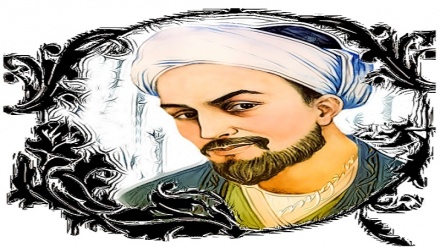Iranian notables, sources of global honor (81)
Today, we study another treatise, authored by Sheikh Shahab Ed-Din Sohrawardi, titled “The Calling of the Simurgh”.
As a reminder, in previous weeks we spoke of the acclaimed and celebrated Iranian mystic and philosopher of 6th Century AH, Sheikh Shahab Ed-Din Sohrawardi. Today, we continue to study the works and services rendered by this renowned philosopher. He played an important role in expansion of Islamic philosophy and mysticism, and is the founder of one of the most important Islamic philosophical schools of thought, named “Illuminism”.
It was said that Sohrawardi was born in Sohraward Village in the vicinity of city of Zanjan in the year 549 AH. He was killed at the age of 38 in the year 587 AH, with the conspiracy of the scholars of the city of Aleppo, upon the order of the Ayoubi Dynasty Founder, Salah Ed-Din Ayoubi. In his short lifespan, Sohrawardi left several works. Part of the works of this Iranian philosopher are treatises and anecdotes, written in allegorical and cryptic style, which according to some researchers, manifest the true and real image of this famed mystic. This group of beautifully written works cover the spiritual and inner experiences of Sohrawardi. In the past weeks, some of the treatises of Sohrawardi, namely “The Chant of Gabriel’s Wing”, “Loghat-e Moran”, and “Fi Haqiqat al-Eshq” that are some of the works of this preeminent philosopher in cryptic, figurative style, in Farsi, were introduced. This week, we get to know another Farsi treatise of this Iranian philosopher, named “The Calling of the Simurgh”.
The most accredited treatise of Sohrawardi on the phases of mysticism, and the secret behind mortality and death is “The Calling of the Simurgh” which is a completely scientific treatise, based on Sohrawardi’s mindset. He has presented this treatise within the framework of a regular structure, in a precise and calculated manner, which equals the most scientific articles of the contemporary era, and has even been compiled in a more accurate and scientific style. In the introduction of the treatise, and in a similar manner to novel scientific preludes, Sohrawardi has introduced the subject, the goal, and the general plot of the text. This introduction, in accordance to the general approach of the books of that era, starts by lauding and praising God Almighty, and the Last and Greatest Messenger of God, Prophet Mohammad (Blessings of God upon him and his progeny). Thereafter, he has presented the theme of this treatise and the related framework.
In this treatise, Sohrawardi, in addition to changing the angle of his stand, has changed the terms of his expression and language, in line with a change in the related meanings and content, which is one of the clear characteristic features of his prose in nearly all of his Farsi treatises. In this manner, he has adopted a simple language in the introduction of this treatise, while choosing a cryptic and figurative language in detailing Simurgh.
Sohrawardi, in order to provide a better understanding of his teachings within this treatise, has presented a short tale in figurative and cryptic style on the characteristic features of the legendary bird, Simurgh. The Simurgh which has been presented by Sohrawardi in this treatise is starkly different to the Simurgh which has been introduced by other thinkers of the domains of philosophy and mysticism, like Avicenna and Ghazali. In fact, this well-established Iranian philosopher and mystic of 6th Century AH has displayed Simurgh in a totally different manner.
Some of the critics of Sohrawardi’s books and treatises opine that in this treatise, Sohrawardi has in fact detailed the path that the wayfarer covers to reach the phase of alertness, vigilance, and knowledge. In fact, the anecdote on Simurgh, in the view of this group of critics marks the beginning of a journey within inner self. This journey has taken place in the spring time, which is the season of development and growth; a season in which according to Sohrawardi, the enlightened ones have liberated themselves from the yoke of instincts and temptations, and have reached out for righteousness.
The characteristic traits which Sohrawardi has enumerated for Simurgh are undoubtedly the traits of a perfected human being who has attained a prominent status, and who awakens the ones that are not vigilant. Within the prelude of this treatise, Sohrawardi has presented the theoretical discussions on the notion of perfected man, and has detailed the conditions and phases which should be fulfilled for this purpose, in a cryptic writing style. In the main text of the treatise, named “The Calling of the Simurgh”, Sohrawardi has elaborated on the practical phases of development and growth in a simple and completely scientific language, thereby establishing a close bond between theory and practice. This is one of the important and significant features of Sohrawardi’s educational approach.
MR/ME


